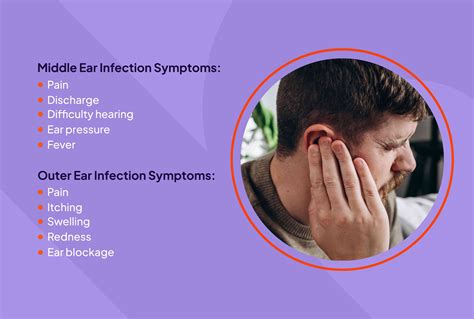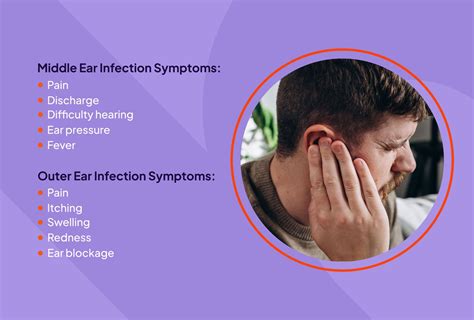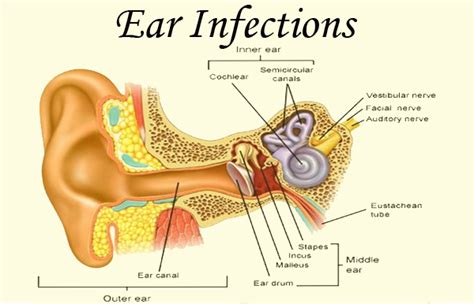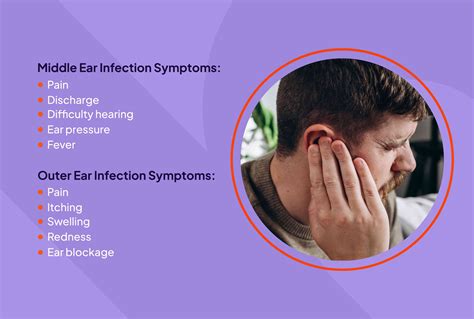Intro
Identify ear infection signs and symptoms, including ear pain, fever, and hearing loss, to seek prompt treatment and prevent complications like eardrum damage and hearing impairment.
Ear infections are a common health issue that affects people of all ages, from infants to adults. They occur when bacteria or viruses infect the middle ear, causing inflammation and fluid buildup. Ear infections can be painful and may lead to more serious complications if left untreated. Recognizing the signs and symptoms of an ear infection is crucial for seeking timely medical attention and preventing potential long-term damage.
Ear infections can be caused by a variety of factors, including colds, flu, and allergies, which can lead to the accumulation of fluid in the middle ear. This fluid can become a breeding ground for bacteria and viruses, resulting in an infection. In addition to these factors, ear infections can also be caused by the insertion of foreign objects into the ear, such as cotton swabs, which can push earwax and debris further into the ear canal.
The importance of understanding ear infection signs and symptoms cannot be overstated. Early detection and treatment can help alleviate symptoms, prevent complications, and reduce the risk of long-term hearing damage. Furthermore, recognizing the signs and symptoms of an ear infection can also help individuals take preventative measures to reduce their risk of developing an infection in the first place. By being aware of the causes and risk factors associated with ear infections, individuals can take steps to protect their ears and maintain good ear health.
Understanding Ear Infections

Types of Ear Infections
There are several types of ear infections, each with distinct characteristics and symptoms. Acute otitis media is the most common type of ear infection and is caused by a bacterial or viral infection. Otitis media with effusion is a type of ear infection that occurs when fluid builds up in the middle ear, but there is no signs of infection. Chronic otitis media is a type of ear infection that occurs when the middle ear becomes inflamed and infected over a long period.Signs and Symptoms of Ear Infections

Some common signs and symptoms of ear infections include:
- Ear pain or discomfort
- Fever
- Hearing loss or difficulty hearing
- Discharge or fluid leaking from the ear
- Vertigo or dizziness
- Feeling of fullness in the ear
- Difficulty sleeping due to ear pain
- Irritability or restlessness
Causes and Risk Factors
Ear infections can be caused by a variety of factors, including colds, flu, and allergies. Insertion of foreign objects into the ear, such as cotton swabs, can also push earwax and debris further into the ear canal, increasing the risk of infection. Additionally, individuals with weakened immune systems, such as those with chronic illnesses or taking immunosuppressive medications, may be more susceptible to ear infections.Diagnosis and Treatment

Treatment for ear infections depends on the type and severity of the infection. Antibiotics may be prescribed to treat bacterial infections, while viral infections may require antiviral medications. Pain relievers, such as acetaminophen or ibuprofen, can help alleviate ear pain and reduce fever. In some cases, a healthcare professional may recommend ear drops or other medications to help relieve symptoms.
Prevention and Self-Care
Preventing ear infections requires good ear hygiene and avoiding insertion of foreign objects into the ear. Regular handwashing, especially during cold and flu season, can help reduce the risk of infection. Avoiding close contact with individuals who have colds or flu can also help prevent the spread of infection. Additionally, individuals can take steps to protect their ears by wearing earplugs or earmuffs in loud environments and avoiding exposure to loud noises.Complications and Long-Term Effects

It is essential to seek medical attention if symptoms persist or worsen over time. A healthcare professional can provide proper diagnosis and treatment, helping to alleviate symptoms and prevent long-term damage.
Seeking Medical Attention
If you or a loved one is experiencing symptoms of an ear infection, it is essential to seek medical attention. A healthcare professional can provide proper diagnosis and treatment, helping to alleviate symptoms and prevent long-term damage. In addition to seeking medical attention, individuals can take steps to protect their ears and maintain good ear health. By being aware of the causes and risk factors associated with ear infections, individuals can take preventative measures to reduce their risk of developing an infection.Conclusion and Next Steps

What are the common symptoms of an ear infection?
+Common symptoms of an ear infection include ear pain, fever, hearing loss, and discharge from the ear. In some cases, individuals may experience vertigo, dizziness, or a feeling of fullness in the ear.
How can I prevent ear infections?
+Preventing ear infections requires good ear hygiene and avoiding insertion of foreign objects into the ear. Regular handwashing, especially during cold and flu season, can help reduce the risk of infection. Avoiding close contact with individuals who have colds or flu can also help prevent the spread of infection.
What are the potential complications of an ear infection?
+If left untreated, ear infections can lead to more serious complications, including hearing loss, speech and language delays, and balance problems. Repeated ear infections can also lead to chronic otitis media, a type of ear infection that can cause long-term damage to the middle ear and eardrum.
